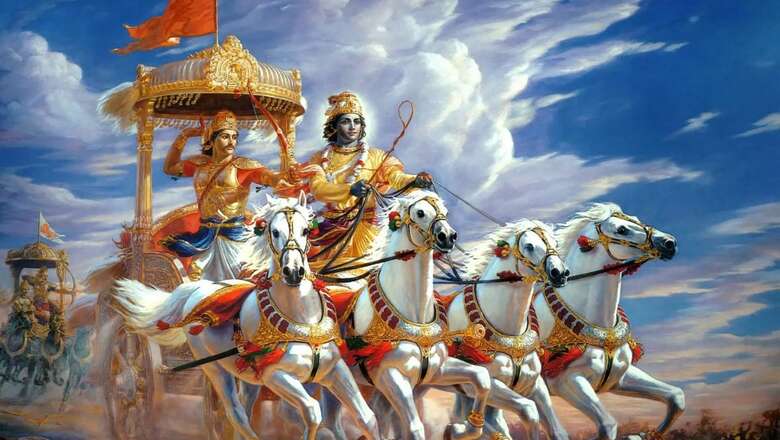
views
Dharayate iti dharma – that which sustains is dharma. Essentially dharma (pronounced dharm) lends itself to different meanings and inferences. But, at its core, dharma means that which is the true nature of a being. It then extends from individual into inter-personal, social and societal dimensions. Hence, dharma finds its interpretations in duty, righteousness, character etc. It’s simple and complex at the same time.
In every form or interpretation, however, dharma seeks to uphold and sustain. It is the process by which the most evolved living being on Earth – humans – can achieve their true potential and aim for a higher consciousness. If everyone did their duty, were truthful and practised righteousness, human society would reach the pinnacle of existence. So, what is the true nature of a human being?
As a student of the Bhagavad Gita, I will endeavour to stick to the instructions of Bhagavan Shri Krsna. They were delivered in the middle of a battlefield to one of the foremost among nara (human beings), Arjun – a learned warrior who had mastered the most advanced warcraft, sciences, conquered sleep, was ambidextrous, all in all a superhuman – by the Supreme Personality of Godhead Shri Krsna, who was 89 years old at the time but did not look a day older than 20. He had come down from the highest dimension (that’s what avatar means) to reinstall dharma (Dharma sansthapanaya sambhavami yuge yuge).
Krsna was born a prince, grew up as a cowherd and delivered the Gita as the charioteer to Arjun. His life on Earth shows that varna was purely based on ability and action and not by birth. In Chapter 4, Krsna says: ‘Catur varnam maya sristham guna karma vibhagasaha‘, which translates to, ‘The four varnas are my creation based on the guna (ability) and karma (action)’.
Hence, the varna-shrama, which is being wrongly criticised and attacked in the current day, is a system based purely on ability and action and not by birth. All the characters in the Mahabharata were named and referred to by their actions and their ability and not by their birth. Yes, there were references to their parents or lineage but their varna was defined by their action and ability.
We make such references today as well. An IT professional is a techie, one in media is a journalist, in police a cop. In our academic format, those with a higher intellect are encouraged to pursue the sciences, those with skill are encouraged to do vocational work, those with an aptitude for book-keeping or accounts or trade enter business while those with poor intellect and ability end up doing menial jobs. It’s a reality all around us. It was the same more than 5,000 years ago. Only then, society referred to them by their varna and not by their caste.
Interestingly, all the characters in Mahabharata and Ramayana are addressed by the first name (there is no surname, which is a colonial concept). The caste, by the way, is a foreign insertion into the Bharatiya way of life. Caste originates from the Portuguese word ‘casta’. And this elitist concept that formally qualified people by birth was further cemented by the colonisers. They did it purely because they couldn’t understand the Bharatiya societal system and the Hindu way of life.
Bharata Desham had the Bhagavad Gita and other scriptures, knowledge of the ancients to guide it all along. The colonisers didn’t. They not only corrupted the system, they also burnt down important texts that listed the guiding principles. The Bhagavad Gita, however, like many other scriptures was preserved.
The Bhagavad Gita, meaning the ‘song of God’, outlines the principles of dharma for humanity. It is the summary of all knowledge that was sung by Krsna in the battlefield, heard by Arjun, Sanjaya, Dhritharashtra, Bhishma and Vyasadeva. It was written down by Krishna Dwaipayana Vyasa who taught it to Vaishampayana and, thereafter, handed down over eons from acharya to shishya in a knowledge-sharing continuum.
Early on in the Gita, Krsna says this knowledge was shared by him first to Vivasvan at the beginning of human society and, thereafter, it was passed on. This Rahasyam hy etad uttamam (‘most confidential knowledge’ from BG 4.3), which was supposed to be passed by a chain of the guru-shishya parampara was lost as the chain of transfer was broken.
Krsna says he is only reviving the chain by sharing this knowledge with Arjun as he is his friend, disciple and a trusted intellectual being elevated in consciousness. So Bhagavan in the Gita establishes clearly that this ‘most confidential yoga’ (or knowledge union of the human to the divine) is not something new. It has been there since the beginning of time and continues to exist. So, this knowledge and instruction by its own nature is ‘Sanatan’ (eternal and continuous). Krsna then says he descends on this planet each time this knowledge is lost and humanity is in the throes of adharm. Whenever the forces inimical to dharma (Dharmasya glanir bhavati from BG 4.7) start assuming dominance, ‘I descend to restore balance and to re-establish the Sanatan Dharm continuum’.
Krsna, upon being questioned by a disillusioned Arjun, goes on to explain what the core principles of dharma are, which a human being must practise and aspire to imbibe so that they rise above the mundane and gain a higher consciousness that brings them closer to the Supreme Bhagavan.
The six pillars of dharma are: truthfulness, compassion, austerity, cleanliness, charity, and spiritual education. “The Supreme Personality of Godhead said: fearlessness; purification of one’s existence; cultivation of spiritual knowledge; charity; self-control; performance of sacrifice; study of the Vedas; austerity; simplicity; non-violence; truthfulness; freedom from anger; renunciation; tranquility; aversion to faultfinding; compassion for all living entities; freedom from covetousness; gentleness; modesty; steady determination; vigour; forgiveness; fortitude; cleanliness; and freedom from envy as well as from the passion for honour – these transcendental qualities, O Son of Bharata, belong to godly men endowed with divine nature.” (BG 16.1-3)
Are any of these qualities undesirable, predatory or discriminatory? Shouldn’t all of humanity aspire to imbibe these qualities?
Krsna further elucidates that the sole purpose of a human being is service, that too with devotion. This message ties back to the core dharma of a ‘jiva tattva’ – to serve the purpose of its creator, the divine supreme from whom all emerges and into whom all converges.
Krsna elucidates that while the body perishes that atma (jiva tattva) lives on and continues on its quest to eventually unite from where it originated (param-atma or Krsna himself).
My limited and simple understanding of a complex text, which has many scientific, philosophical and Daivic layers, lead me to believe that it is human beings that have corrupted an eternal system of sustenance. Sadly, those that have chosen to deviate from the Sanatan path and choose another are busy defaming it.
Even there Krsna says in the Gita that it is important that the jiva has faith. Wherever, whoever the jiva has faith or devotion in for whatever material benefit, I place the faith in that devata. ‘But, know Arjun that all these devatas are but part manifestations of me. Eventually, it all comes back to me. Mamaivamsho jeeva loke jeeva bhutah sanatana (BG 15.7)’.
As Arjun finds his doubts dispelled and his purpose revealed, he accepts Krsna as the maintainer of the eternal dharma, or Sanatan Dharma (BG 11.18). And, that is why, Krsna says Sarva dharman parityajya mam ekam sharanam vraja, which translates to ‘Give up all other duties/desires/faith, just commit yourself unto me, my service, Aham tvam sarva papebhyo moksha ishyami ma sucha (I will deliver you from all bad karma and grant you moksha, which means ‘free your atma from this cycle of material existence’ – BG 18.66).
The beauty of Sanatan Dharma is that it allows all forms of faith and manifestation. Yet, it continues. Yet, it prevails. Yet, it is eternal. Those who want to eradicate Sanatan Dharma will perish soon in this cycle of their life but their atma will enter another form as that is the Sanatan law mandated by Bhagavan. However, their actions (karma) in this life will be the residue that the atma carries into its next. Their karma will determine whether the atma that resides in their body rises to a higher plane or slips in the mortal order.
Dharma eva hato hanti/dharmo rakshati rakshitah, which means dharma protects those who protect it and destroys those who try to destroy it.
(Views expressed in the above piece are personal and solely that of the author. They do not necessarily reflect News18’s views)


















Comments
0 comment